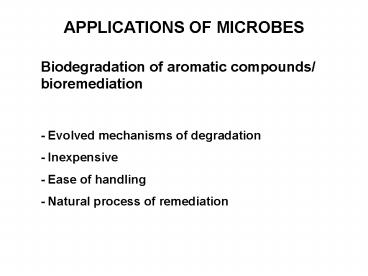Biodegradation of aromatic compounds bioremediation - PowerPoint PPT Presentation
1 / 8
Title:
Biodegradation of aromatic compounds bioremediation
Description:
Chemical intermediate to produce other chemicals (phthalate anhydride and carbaryl) ... Reported to be teratogenic, estrogenic and mutagenic ... – PowerPoint PPT presentation
Number of Views:1711
Avg rating:3.0/5.0
Title: Biodegradation of aromatic compounds bioremediation
1
APPLICATIONS OF MICROBES
Biodegradation of aromatic compounds/
bioremediation
- Evolved mechanisms of degradation -
Inexpensive - Ease of handling - Natural process
of remediation
2
Applications of Aromatic Compounds
- Synthetic textile fibers
- Building and construction products
- Automobiles and paints
- Toy and Cosmetic industry
- Medical devices
- Household fumigant, such as in mothballs
- Chemical intermediate to produce other chemicals
(phthalate anhydride and carbaryl) - Preparation synthetic dyes
- Chiefly used as insecticide
3
Toxicity of Aromatic compounds
- Phthalates
- Plasticizer leaches out by various organic
solvents and biological fluids - Shorter chain esters More toxic
- Reported to be teratogenic, estrogenic and
mutagenic - Suppressed calcium signaling in nicotinic
acetylcholine receptors
- Naphthalene
- Exposure to large amounts of naphthalene cause
nausea, vomiting, diarrhea, blood in the urine,
and jaundice - The International Agency for Research on Cancer
(IARC) classifies naphthalene as possibly
carcinogenic to humans Group 2B - acute exposure causes cataracts in humans, rats,
rabbits, and mice and hemolytic anemia in
children and infants
- Carbaryl
- It is a cholinesterase inhibitor and toxic to
humans with excessive exposure
4
Aromatic compound metabolism
- Growth of an organism on the PAH substrate
- Mineralization of the PAH substrate in the
absence of detectable growth - Transformation of the PAH substrate to
non-mineral, terminal products
Microorganisms
Bacteria completely degrade or
co-metabolize Fungi - transformation Algae -
transformation
5
(No Transcript)
6
Ring Hydroxylating Dioxygenases
NADH
NAD
Ring cleavage Dioxygenases
7
(No Transcript)
8
- - Isolating and identification
- of metabolites
- Biotransformation studies
- - Whole-cell Oxygen uptake
- - Enzyme activity studies































